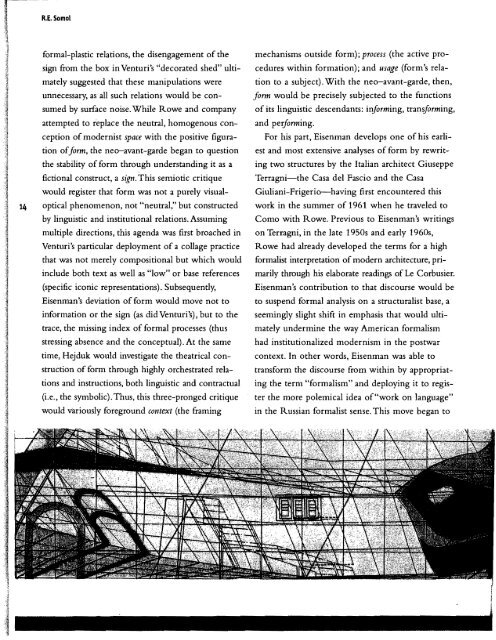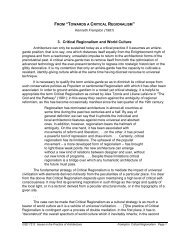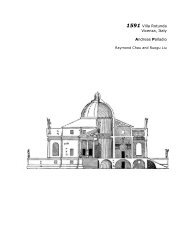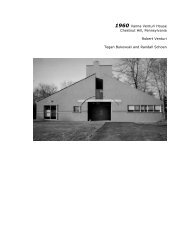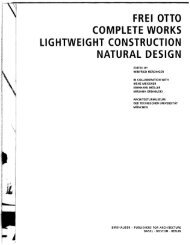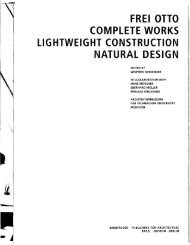Dummy Text, or The Diagrammatic - Introduction
Dummy Text, or The Diagrammatic - Introduction
Dummy Text, or The Diagrammatic - Introduction
Create successful ePaper yourself
Turn your PDF publications into a flip-book with our unique Google optimized e-Paper software.
14<br />
R.E.Somol<br />
f<strong>or</strong>mal-plastic relations, the disengagement of the<br />
sign from the box in Venturi's "dec<strong>or</strong>ated shed" ulti<br />
mately suggested that these manipulations were<br />
unnecessary, as all such relations would be con<br />
sumed by surface noise. While Rowe and company<br />
attempted to replace the neutral, homogenous con<br />
ception of modernist space with the positive figura<br />
tion off<strong>or</strong>m, the neo-avant-garde began to question<br />
the stability of f<strong>or</strong>m through understanding it as a<br />
fictional construct, a sign. This semiotic critique<br />
would register that f<strong>or</strong>m was not a purely visual<br />
optical phenomenon, not "neutral," but constructed<br />
by linguistic and institutional relations. Assuming<br />
multiple directions, this agenda was first broached in<br />
Venturi's particular deployment of a collage practice<br />
that was not merely compositional but which would<br />
include both text as well as "low" <strong>or</strong> base references<br />
(specific iconic representations). Subsequently,<br />
Eisenman's deviation of f<strong>or</strong>m would move not to<br />
inf<strong>or</strong>mation <strong>or</strong> the sign (as did Venturi's), but to the<br />
trace, the missing index of f<strong>or</strong>mal processes (thus<br />
stressing absence and the conceptual). At the same<br />
time, Hejduk would investigate the theatrical con<br />
struction of f<strong>or</strong>m through highly <strong>or</strong>chestrated rela<br />
tions and instructions, both linguistic and contractual<br />
(i.e., the symbolic). Thus, this three-pronged critique<br />
would variously f<strong>or</strong>eground context (the framing<br />
mechanisms outside f<strong>or</strong>m); process (the active pro<br />
cedures within f<strong>or</strong>mation); and usage (f<strong>or</strong>m's rela<br />
tion to a subject). With the neo-avant-garde, then,<br />
f<strong>or</strong>m would be precisely subjected to the functions<br />
of its linguistic descendants: inf<strong>or</strong>ming, tranif<strong>or</strong>ming,<br />
and perf<strong>or</strong>ming.<br />
F<strong>or</strong> his part, Eisenman develops one of his earli<br />
est and most extensive analyses of f<strong>or</strong>m by rewrit<br />
ing two structures by the Italian architect Giuseppe<br />
Terragni-the Cas a del Fascio and the Cas a<br />
Giuliani-Frigerio-having first encountered this<br />
w<strong>or</strong>k in the summer of 1961 when he traveled to<br />
Como with Rowe. Previous to Eisenman's writings<br />
on Terragni, in the late 1950s and early 1960s,<br />
Rowe had already developed the terms f<strong>or</strong> a high<br />
f<strong>or</strong>malist interpretation of modern architecture, pri<br />
marily through his elab<strong>or</strong>ate readings of Le C<strong>or</strong>busier.<br />
Eisenman's contribution to that discourse would be<br />
to suspend f<strong>or</strong>mal analysis on a structuralist base, a<br />
seemingly slight shift in emphasis that would ulti<br />
mately undermine the way American f<strong>or</strong>malism<br />
had institutionalized modernism in the postwar<br />
context. In other w<strong>or</strong>ds, Eisenman was able to<br />
transf<strong>or</strong>m the discourse from within by appropriat<br />
ing the term "f<strong>or</strong>malism" and deploying it to regis<br />
ter the m<strong>or</strong>e polemical idea of"w<strong>or</strong>k on language"<br />
in the Russian f<strong>or</strong>malist sense. This move began to


